Best Cattle Breeds for Milk Production
When it comes to dairy farming, choosing the right cattle breed can have a big impact on milk production. Some breeds naturally produce significantly more milk than others, making them ideal for commercial dairy operations or even small homesteads.
In this blog article, we will discuss and explore the top 8 cattle breeds that produce the highest milk yields and also, will discuss key factors to consider when the breed for milk production.
Best 8 Cattle Breeds for Milk Production
Holstein
The Holstein is the world’s highest-production dairy cattle breed. Originating from the Netherlands, Holsteins have been selectively bred over the last century to prioritize milk production over other traits.
As a result, Holsteins now produce on average 22,530 pounds (10,206 liters) of milk per lactation – far surpassing any other dairy cattle breed.
Their high milk yields, combined with good fertility and reasonable feed-to-milk conversion efficiency, make Holsteins the most popular dairy cows globally. They account for over 90% of all US dairy cattle.
Jersey
Known as the “butterfat champions”, Jersey cattle produce milk with the highest butterfat and protein content of all dairy breeds.
While their average milk yield of 16,825 pounds (7,639 liters) per lactation pales in comparison to Holsteins, what they lack in quantity Jersey cows make up for in quality. The high nutrient density of Jersey milk makes it perfect for products like butter, cheese, and ice cream.
Jerseys also excel in grazing systems thanks to their efficient metabolism and ability to thrive on pasture.
Brown Swiss
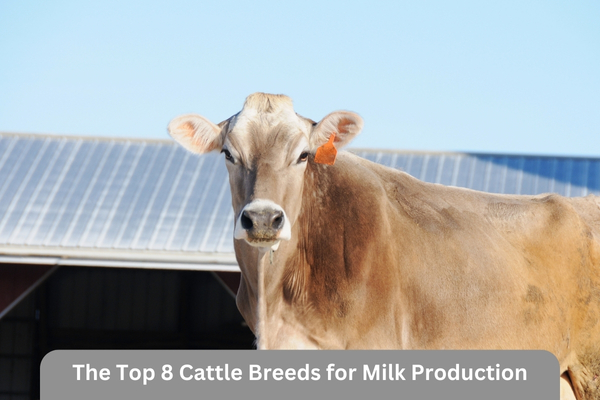
Brown Swiss cattle originated in the Swiss Alps, giving them excellent cold tolerance and longevity. Brown Swiss cows produce an impressive 18,250 pounds (8,289 liters) of milk per lactation on average.
They are docile, strong animals that convert feed efficiently. Brown Swiss milk also has favorable components for cheese production. However, Brown Swiss are not as heat tolerant as some other dairy breeds.
Guernsey
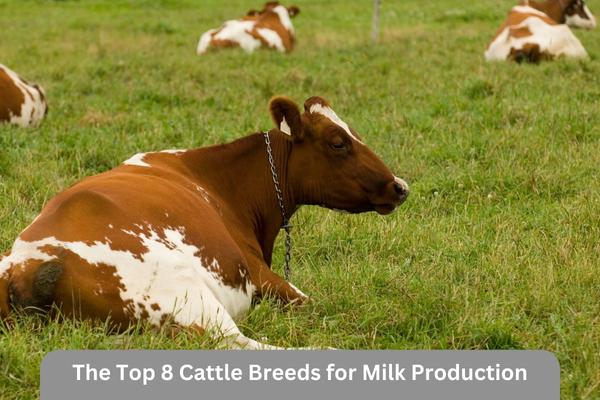
Hailing from the small Isle of Guernsey in the English Channel, Guernsey cattle produce rich, golden milk prized for its flavor and quality.
While Guernseys yield a modest 14,100 pounds (6,396 liters) of milk per lactation, their milk has one of the highest fat and protein contents out of all dairy breeds. As a result, Guernsey milk and dairy products often fetch higher prices in niche markets. These strong-boned, medium-sized cattle also excel on pasture.
Ayrshire
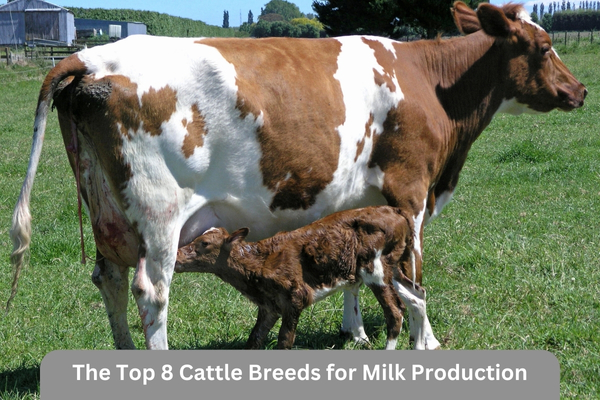
Ayrshire cows originated from County Ayr in Scotland. On average, Ayrshires produce around 16,200 pounds (7,352 liters) of milk per 305 day lactation.
Their milk is ideal for cheese and butter thanks to decent protein and fat levels. Ayrshires are known for being very hearty and hardy cattle.
They adapt well to varied conditions and terrain, doing well in both intensive and extensive production systems. Their red and white spotted coats also make Ayrshires visually striking cattle.
Milking Shorthorn
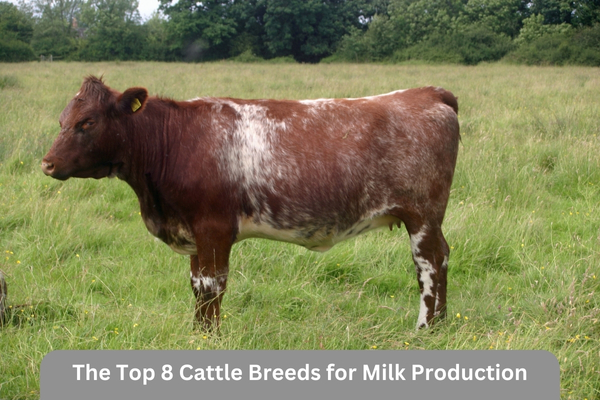
As a dual-purpose breed, Milking Shorthorn cattle provide both milk and meat. While not as specialized as some dairy breeds, Milking Shorthorns still produce a respectable 14,500 pounds (6,577 litres) of milk per lactation.
Their milk contains favourable levels of protein, fat, and other solids. Easy calving and pleasant temperaments are some of the many merits of Milking Shorthorn cows beyond the udder. They make great beginner cattle for homesteads thanks to their versatility and docility.
Normande
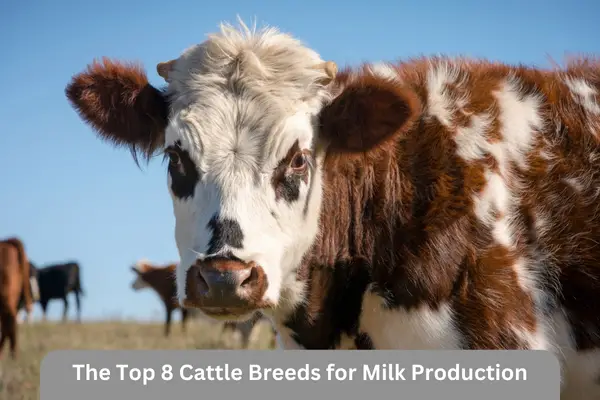
Originally from Normandy, France, Normande cows offer high yields without some of the health issues plaguing overly refined modern dairy breeds.
Under favorable conditions, Normande cattle produce around 18,000 pounds (8,165 liters) of quality milk per lactation.
They tend to have excellent longevity thanks to great fertility, trouble-free calving, and resistance to mastitis. As docile and relatively small cattle, Normandes work well in tie-stall barns and intensive grazing systems.
Swedish Red
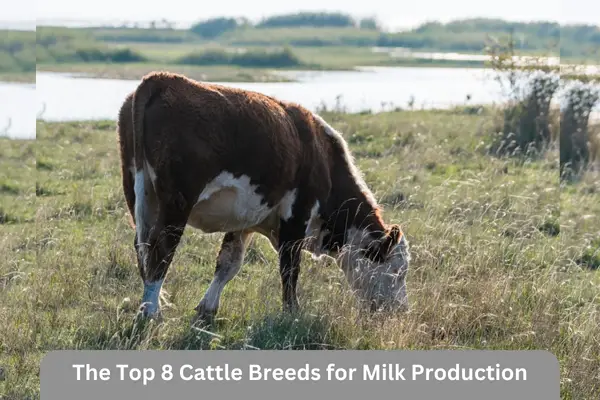
Last but not least, Swedish Red cattle offer fantastic milk production alongside longevity and health traits. Originally from Sweden, Swedish Reds yield 16,800 pounds (7,627 liters) of milk per lactation with great protein and fat ratios.
They live very long, productive lives while maintaining fitness, fertility, and udder health into old age. Their milk also has uniquely high levels of beneficial nutrients like selenium and beta-carotene. As easy calvers and keepers with calm dispositions, Swedish Reds make wonderful family cows.
Key Factors to Consider When Choosing a Dairy Breed
Selecting the right dairy cattle breed requires carefully weighing your farm-specific conditions against breed traits. Here are some key considerations:
Climate and Environment
Take stock of your climate, landscape, and other environmental factors. Heat-tolerant, hardy breeds like Gurnseys and Milking Shorthorns excel in humid climates while Nordic breeds like Swedish Reds and Ayrshires better suit colder regions.
Also, consider seasonal extremes, mud, parasites, and available natural shelter when matching cattle to your farm’s conditions.
Feed Resources and Nutrition
Assess pasture quality and availability along with harvested and purchased feeds. High production breeds like Holsteins require excellent nutrition to reach genetic potential while moderate milkers like Normande can thrive on lower quality forage.
Grouping cattle by nutritional need and production potential can help streamline feeding.
Labor and Management Style
Think about your stockmanship abilities along with labor availability and workflow preferences. Breeds like Jersey and Dexter are smaller in stature and may suit smaller operators.
Sexed semen can also produce targeted heifer calves to simplify replacements. Finally, incorporate preferences for specialized dairy systems like once-a-day milking or intensive rotational grazing when selecting appropriate dairy breeds.
Markets and Milk Utilization
If selling fluid milk, components like butterfat and protein influence pay prices in some markets. Value-added dairy products like gelato and cheese rely on high solids content.
Heirloom or heritage breeds may open niche branding opportunities that fetch premium prices. Even meat and hide value differ between breeds and bulls versus cull cows. Carefully investigate options before settling on target markets.
Personality and Disposition
Don’t underestimate the value of pleasant cattle personalities in small-scale dairy operations. Aggressive, flighty, or hard-to-handle cattle introduce unwanted stress and safety issues. Prioritize docile breeds like Brown Swiss, Jersey, or Dexter if working cattle solo.
The optimal dairy cow for your situation balances production potential with practical breed adaptations to your systems and resources.
Avoid extremely specialized genetics that depend too heavily on expert management. Seek overall functional efficiency suited to your real working conditions when selecting cattle.
Crossbreeding Dairy Cattle for Hybrid Vigor
While pure breeds have merits, crossbreeding opens new possibilities for blending complementary traits. By mixing genetics of two dairy breeds or dairy and beef breeds, calves often exhibit hybrid vigor that outpaces even the best parent stock.
Common dairy cattle crosses like Holstein-Jersey or Angus-Holstein combine high milk production with enhanced fertility, calf viability, and longevity. The first generation of crossbred calves see the most significant hybrid boosts, but benefits persist into subsequent generations.
Rotational crossbreeding plans leverage both hybrid vigor and breed specificity by gradually changing the breed emphasis over generations. One simple plan might use Holstein, Jersey, and Swedish Red genetics in rotation. More complex schemes incorporate additional breeds.
Specific crosses harness production potential with practical health and fitness traits so valued in sustainable, pasture-based dairies.
They present an appealing option for moderate-sized operations seeking to maximize quality of life and profits rather than chasing extreme per-cow production.
Choosing the Best Breed for Your Farm
There are many great dairy cattle breeds to choose from, and there is no universally “best” breed. The ideal dairy cow depends heavily on your specific farm conditions, management system, and production goals.
When selecting cattle, prioritize breeds that will thrive under your farm’s environment and complement your philosophies on animal agriculture.
Focus on productive, fertile, healthy cattle that convert feed efficiently without pushing the biological limits. If selling milk or dairy products, also consider market demand and prices rewarded for certain milk compositions and speciality breeds when planning your dairy herd’s genetics.


